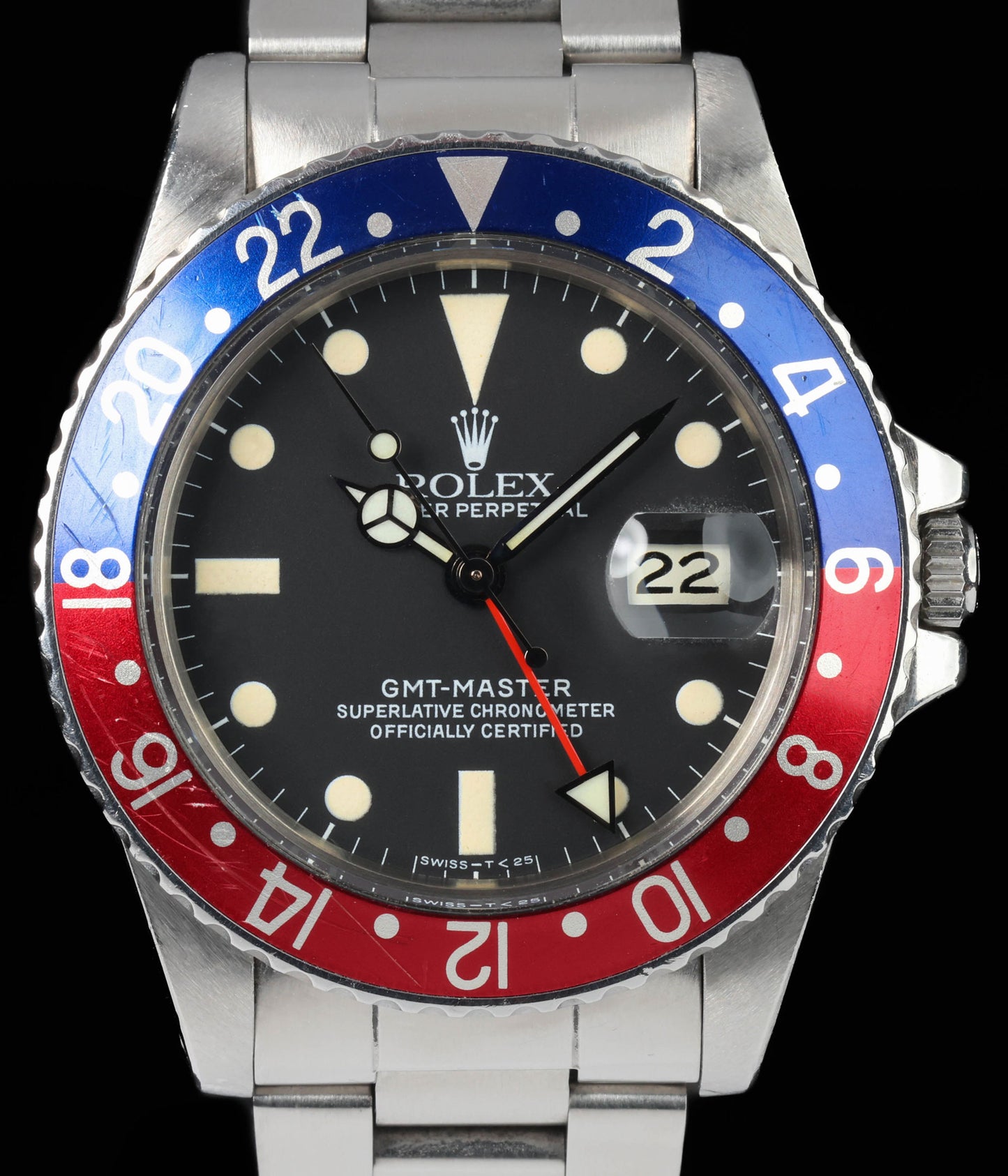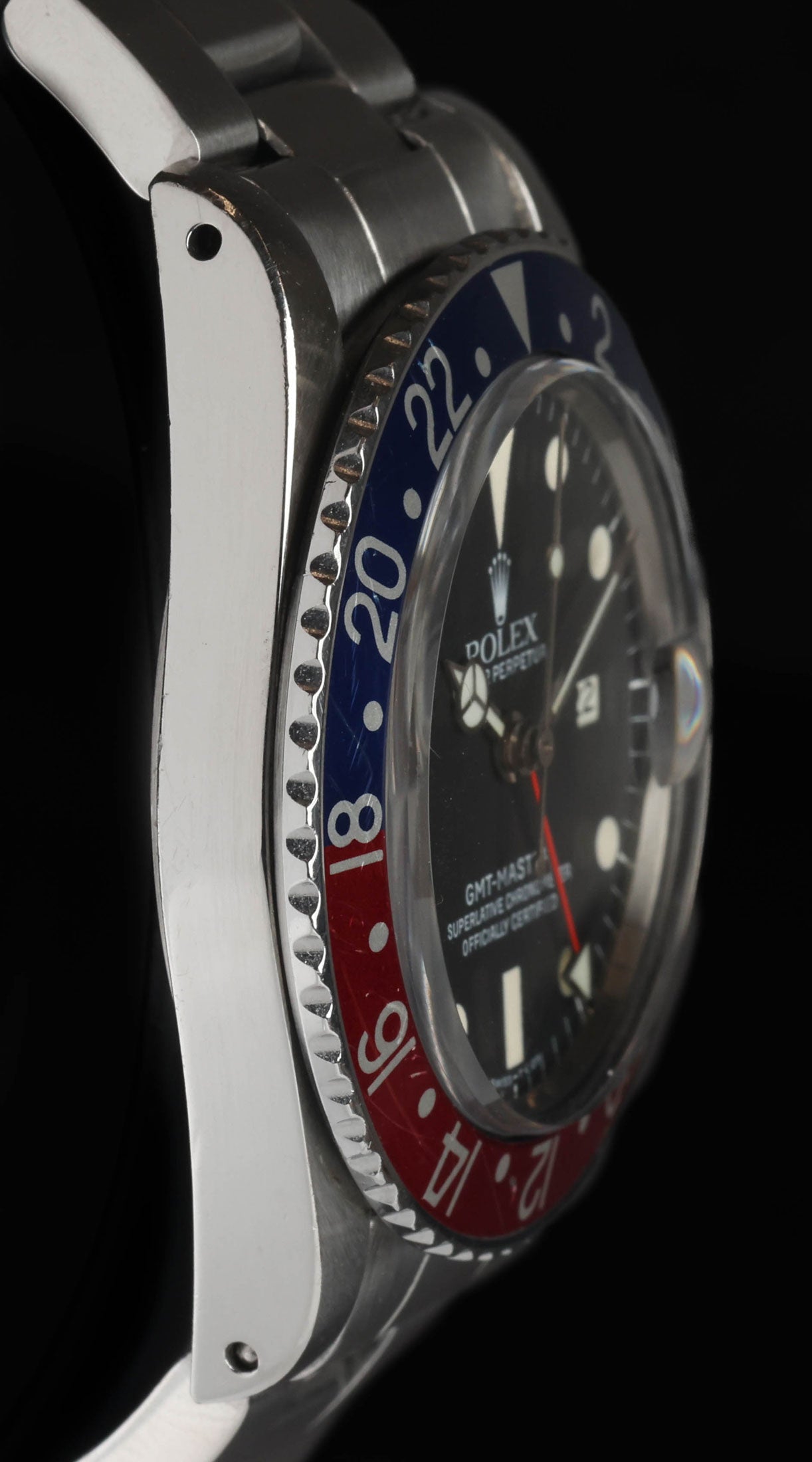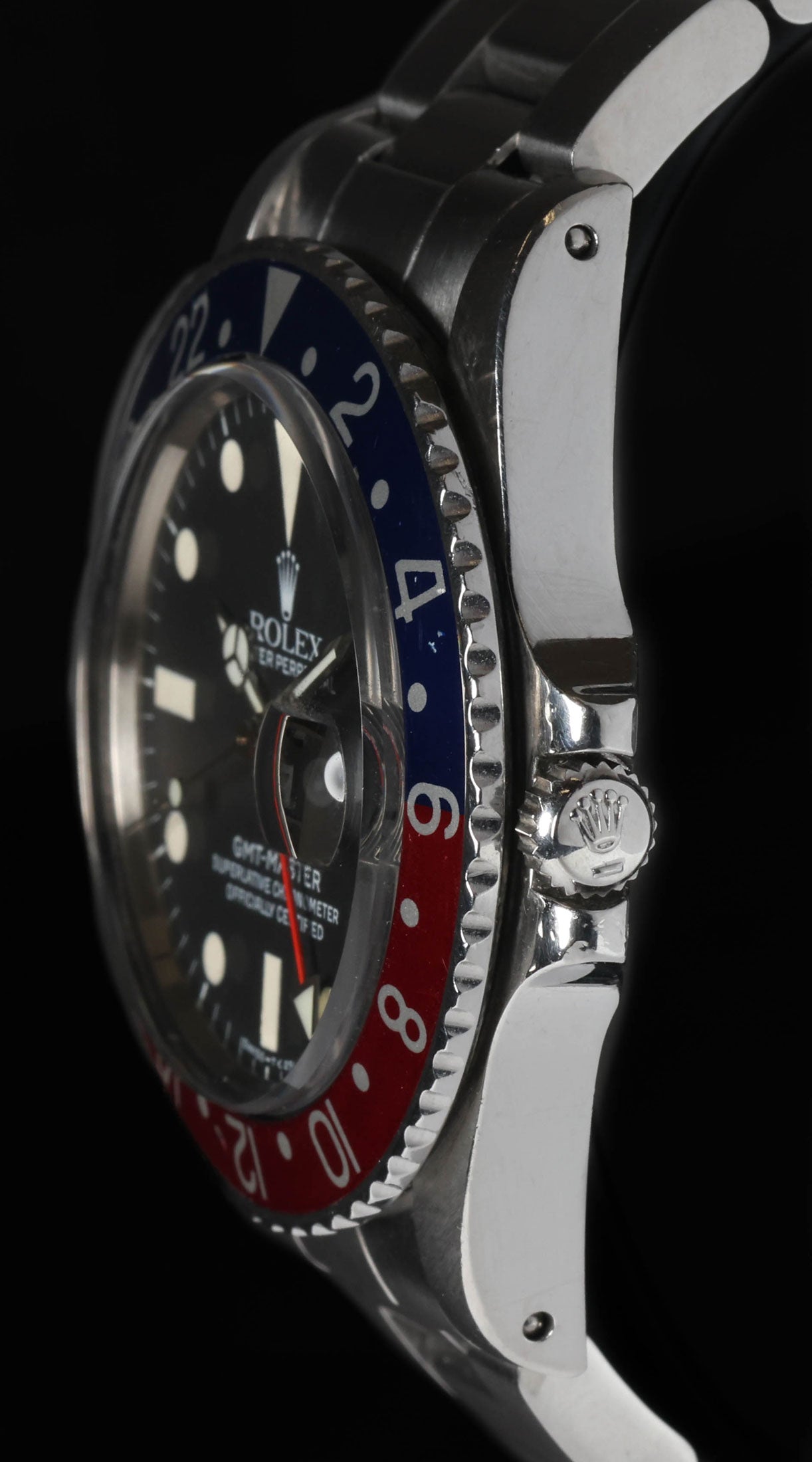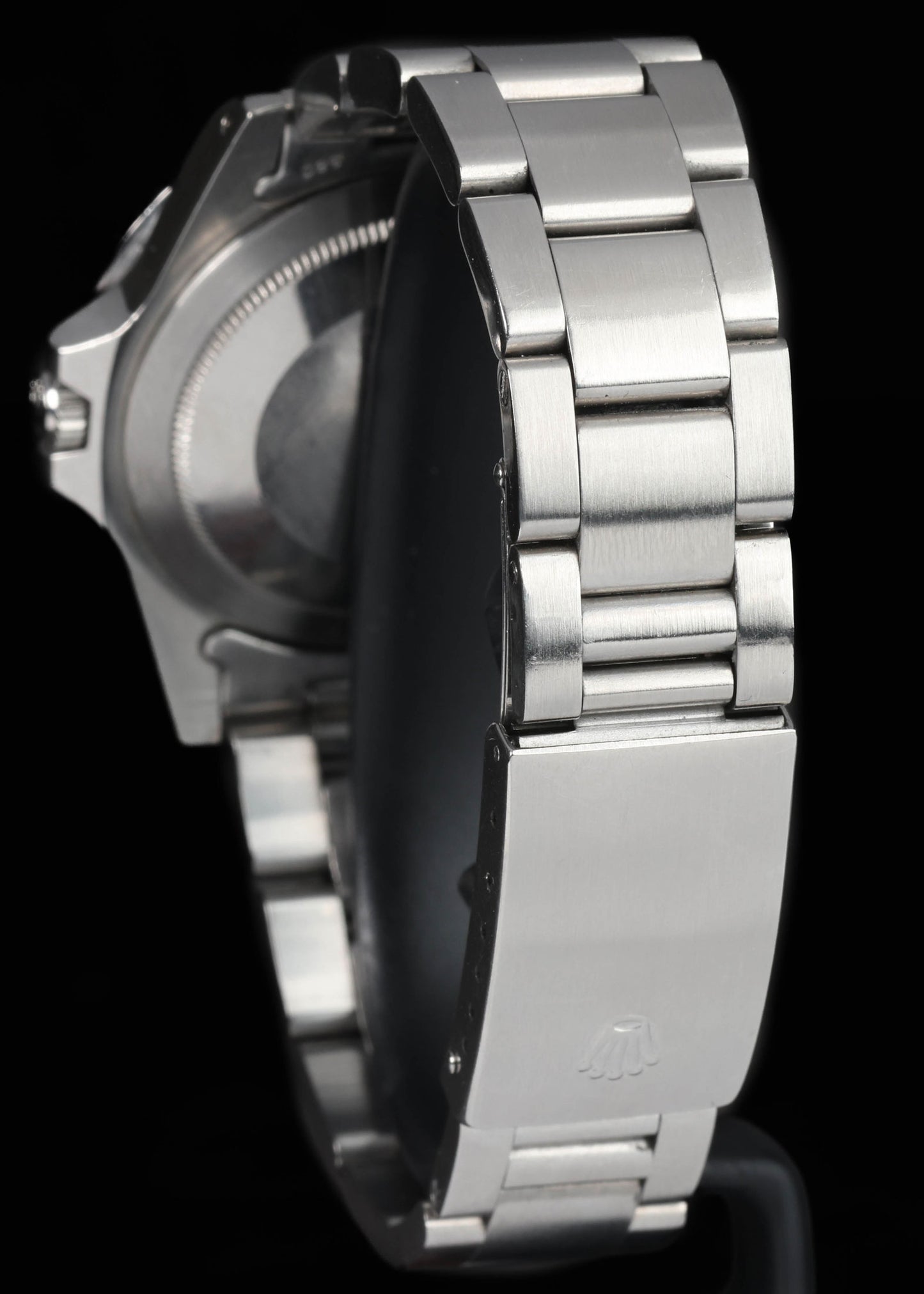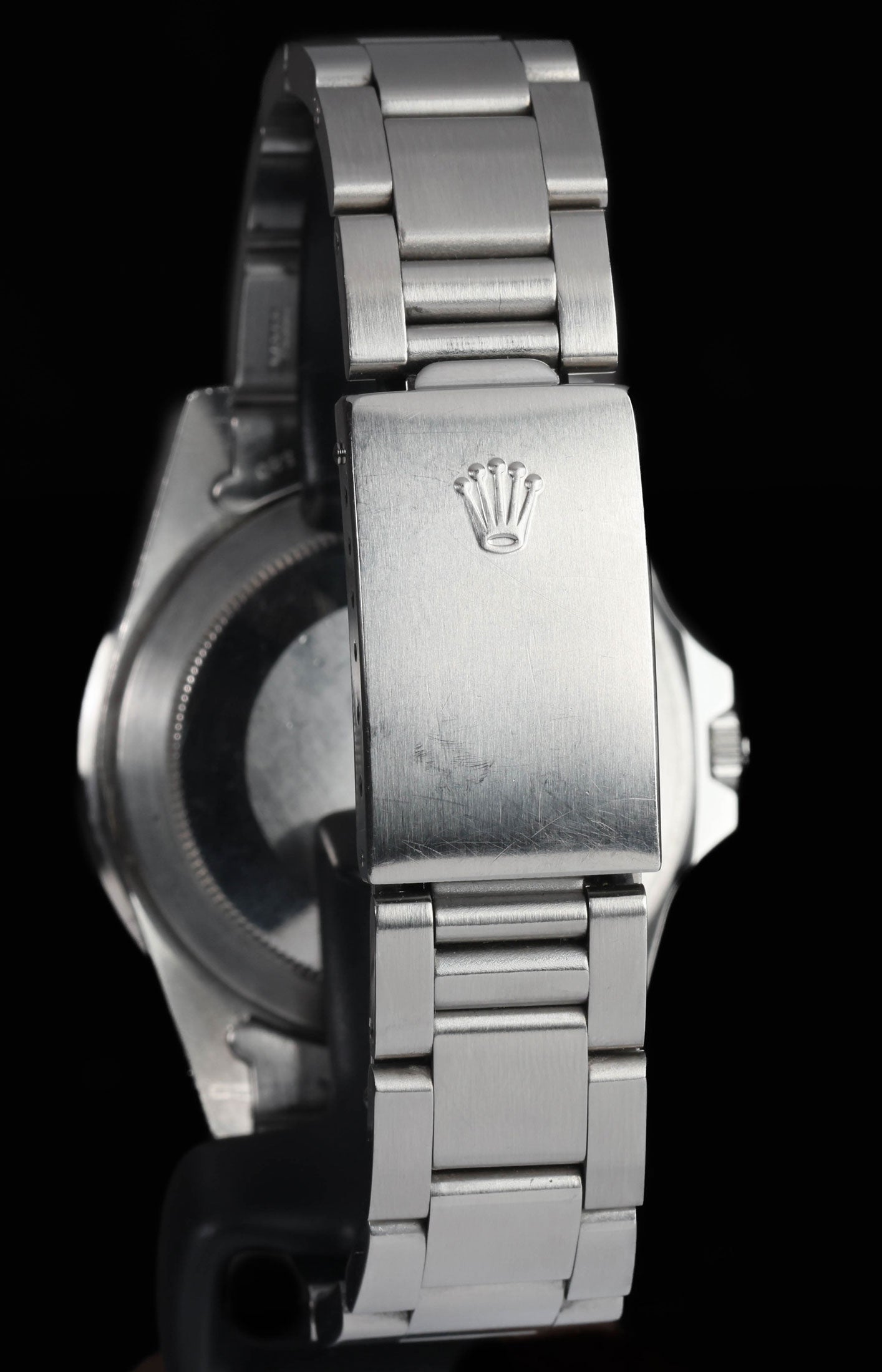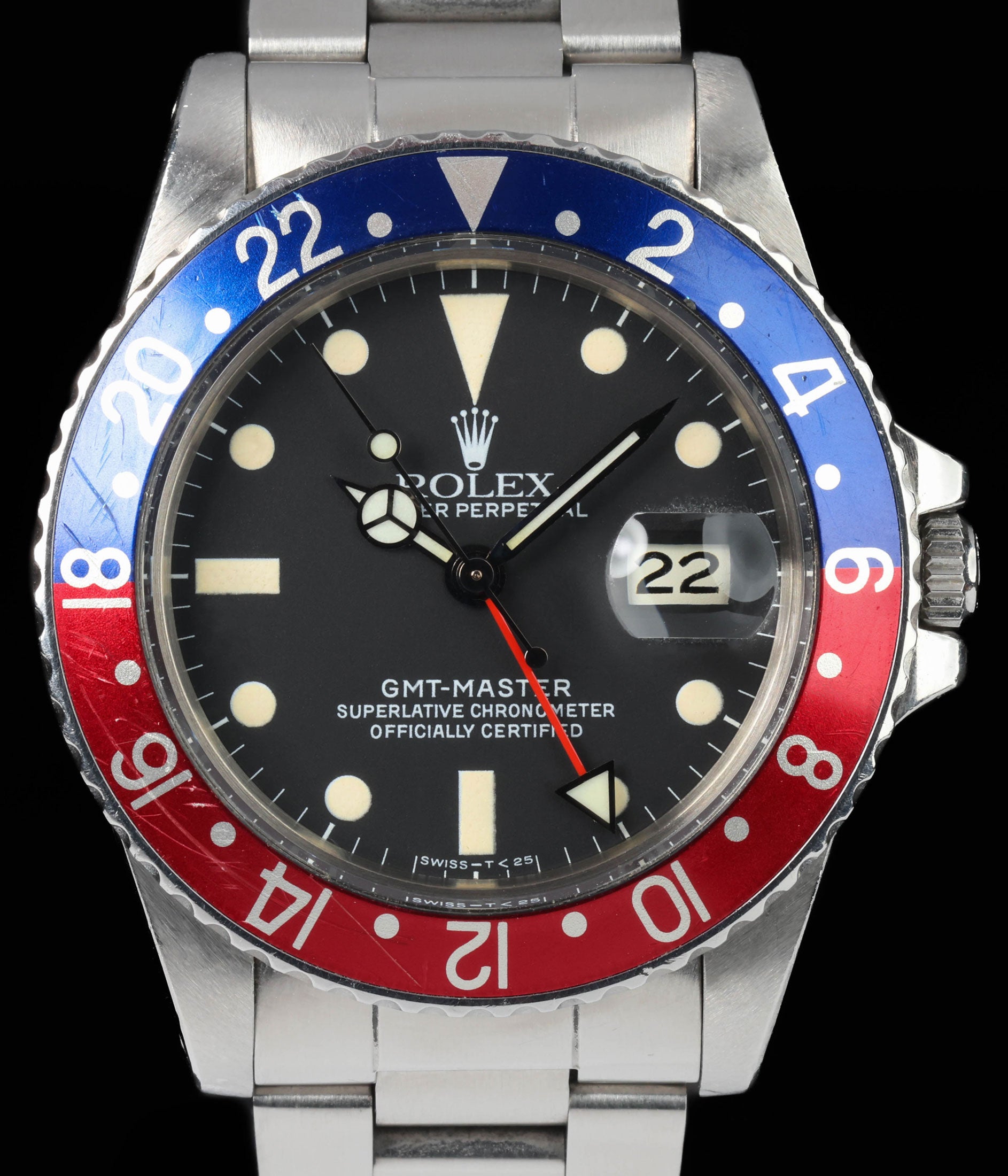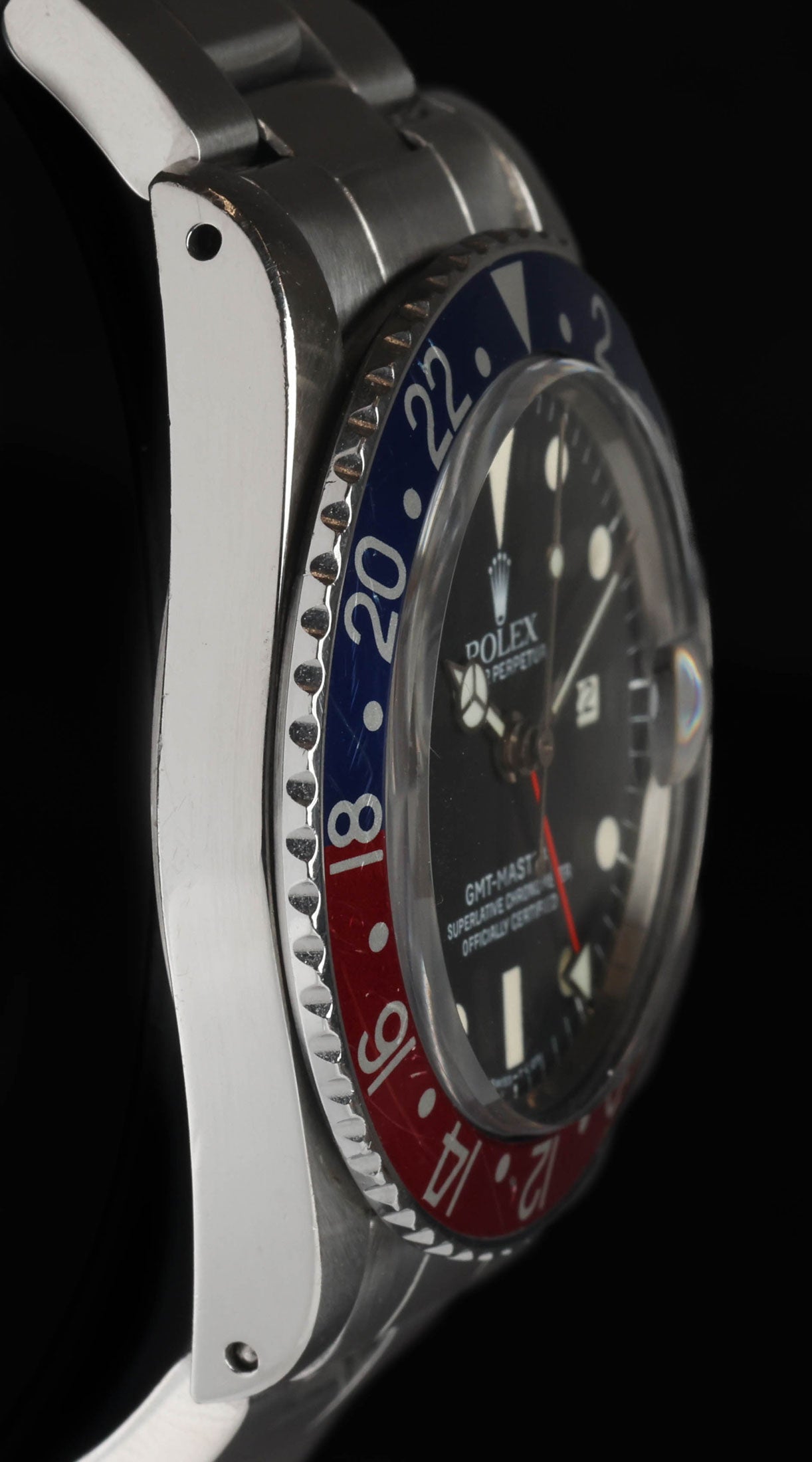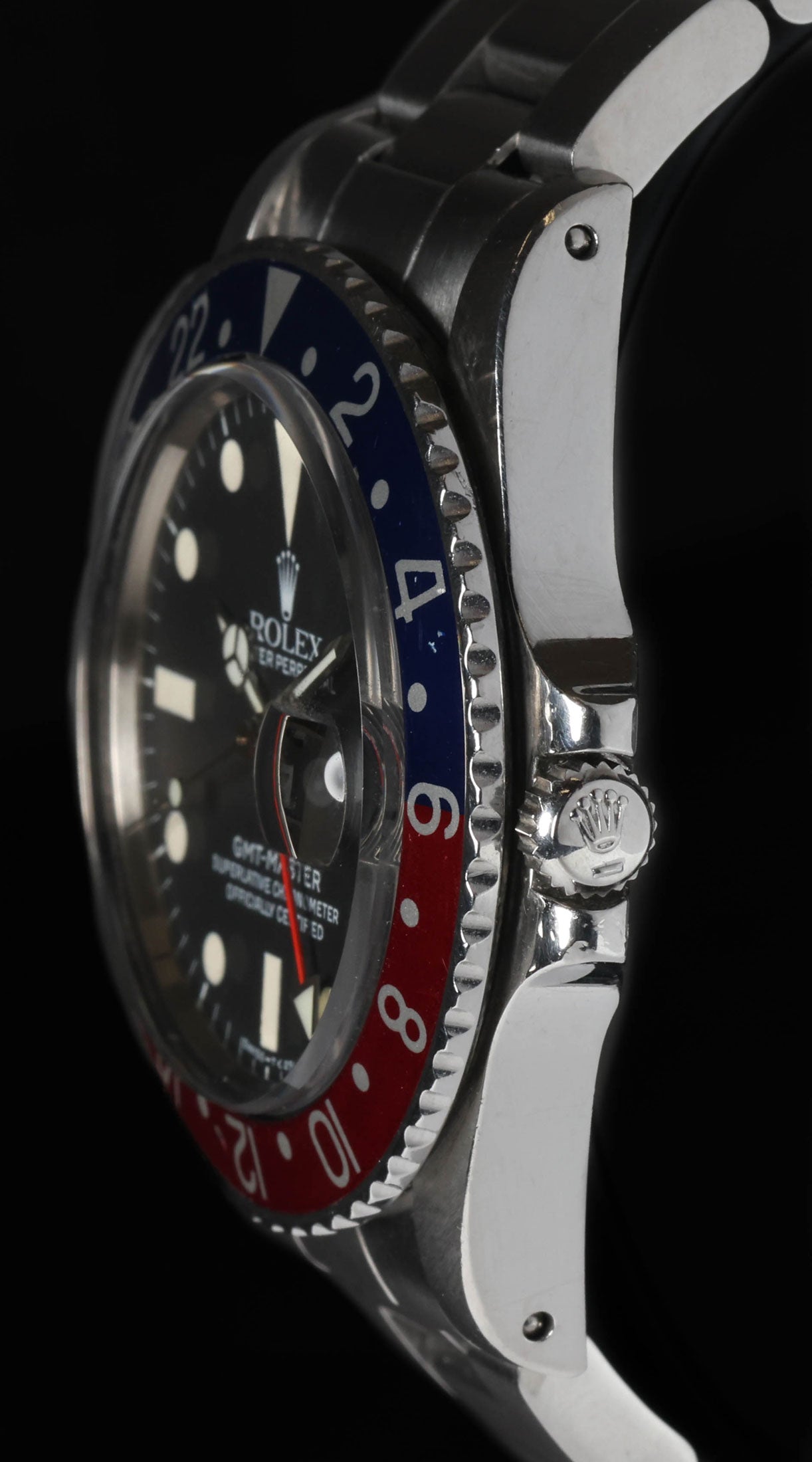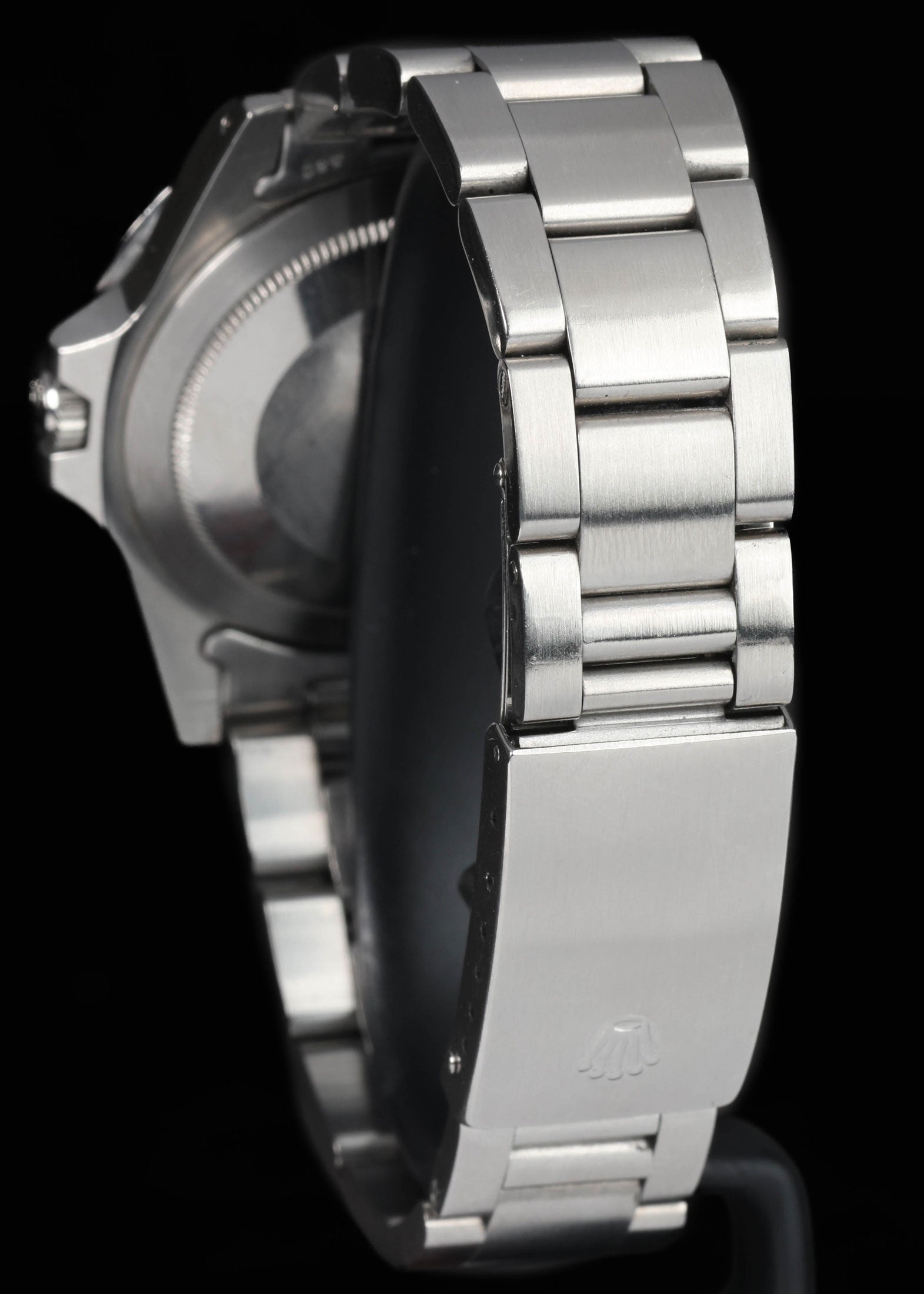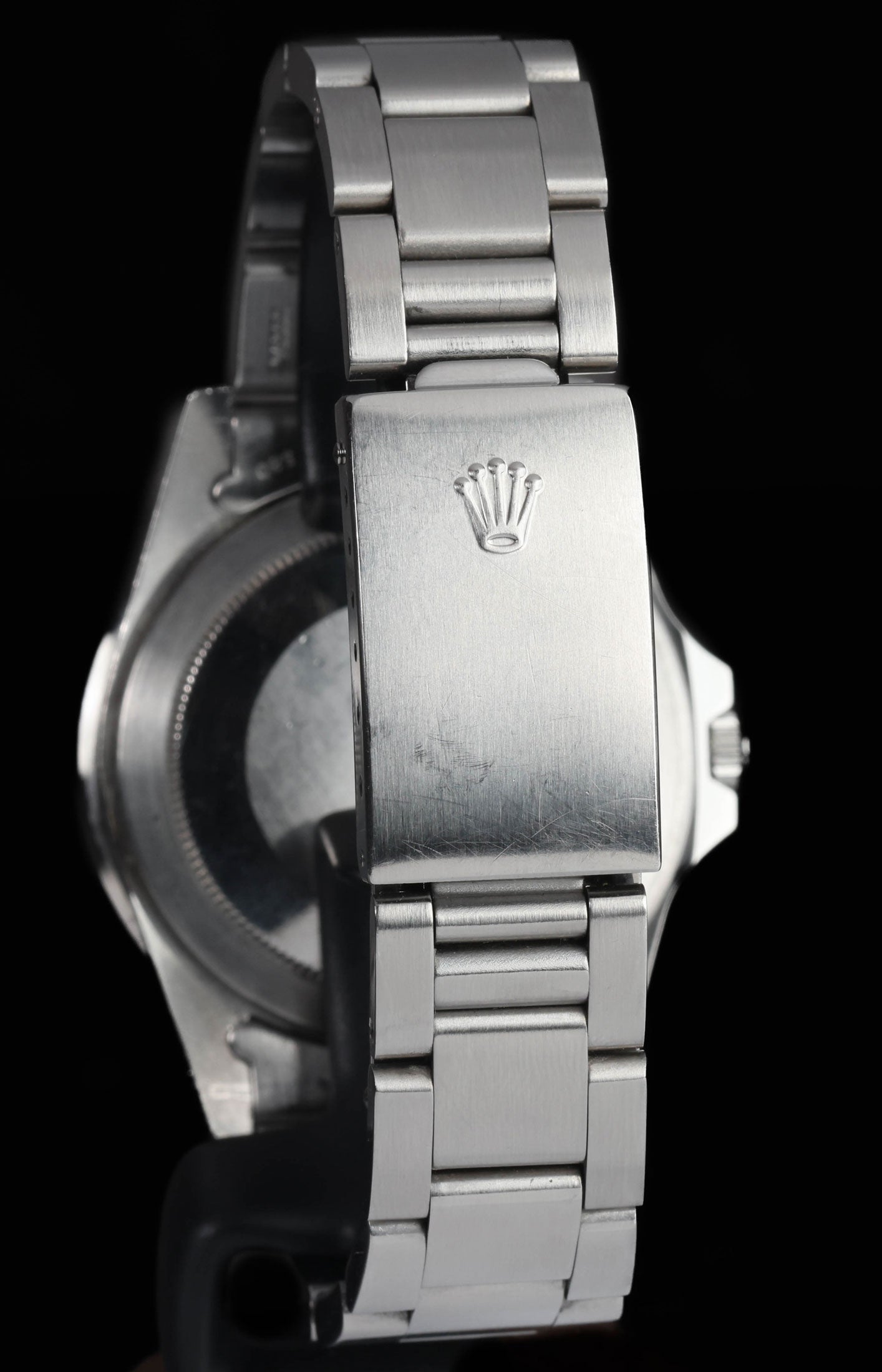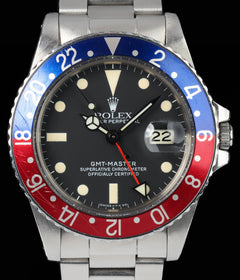Crown Vintage
Rolex GMT Master 16750 'Pepsi' 1984
Rolex GMT Master 16750 'Pepsi' 1984
Couldn't load pickup availability
Rolex GMT Master 16750 'Pepsi'
The stainless-steel case remains in notably strong condition, exhibiting only minor surface hairlines on close inspection and no impact dents or deep scratches. Factory contours, including lug chamfers and vertical brushing, appear untouched, supporting the impression that the case has never been polished.
Its matching Oyster bracelet mirrors the head’s quality: links articulate smoothly with minimal longitudinal stretch, and the clasp closes with a reassuring snap. Fine hairlines are present across the clasp blade and some outer links, but they sit well within expectations for honest use rather than abuse.
The matte dial is excellent, the original printing remaining razor-sharp and free of blemishes. Hour plots have mellowed into a light, even patina that adds depth without compromising legibility. Hands have been replaced at service and therefore show crisp luminant and bright metal surfaces that differ subtly from the dial plots; the change is period-correct for maintenance and presents no functional drawback. Crystal clarity is unmarred, with no chips or scratches distracting from the display.
Although the manufacturer rated this model for water resistance, no mechanical watch should be worn in the shower, where heat and detergents can compromise gaskets over time. If the piece is more than three decades old, it should also be treated strictly as a vintage timepiece and kept clear of swimming or prolonged immersion.
Share
Why we love this watch
Why we love this watch
Rolex GMT-Master 16750
Origins of the GMT-Master
Rolex conceived the GMT-Master in 1954 to help trans-Atlantic crews track Greenwich Mean Time alongside local time during the dawn of jet travel. Early references 6542 and 1675 cemented the 24-hour bezel, red 24-hour hand and high-contrast dial, creating a tool that became synonymous with global aviation and later everyday travel.
Reference 16750: Evolution in the Jet Age
Launched in 1981, reference 16750 bridged the vintage acrylic era and the later sapphire GMTs. It introduced calibre 3075, bringing a higher 28,800 vph beat rate, hacking seconds and, crucially for travellers, the quick-set date feature. Water resistance doubled to 100 m thanks to improved crown-tube sealing, yet the watch retained the slim Oyster profile that made its predecessor such an easy wearer. By 1984 production had settled into the eight-million serial range, with most examples still fitted with the classic matte tritium dial and the aluminium blue-and-red “Pepsi” insert that remains emblematic of the line.
Case, Bezel and Crystal
The 40 mm Oystersteel case is milled from 904L alloy, chosen for its superior corrosion resistance under the varied cabin humidity and tropical stopovers common to 1980s long-haul flying. Crown guards hug the Triplock crown, and the screw-down back preserves structural rigidity. The bidirectional bezel carries its anodised aluminium insert split between midnight blue and bright red: blue for night-time hours, red for daylight. Each half shows twelve crisp numerals, allowing instant differentiation between day and night at a glance. Sitting proud of the bezel is the domed Tropic 25-116 plexiglass crystal, complete with its magnifying cyclops over the date. The acrylic’s slight distortion softens dial reflections and contributes to the warmth many enthusiasts associate with pre-sapphire Rolex sports models.
Dial and Hands
Most 1984 dials remain matte black with painted tritium plots, a layout prized for its glare-fighting clarity. The familiar triangle at 12, rectangles at six and nine, and lume-filled batons elsewhere give a balanced geometric rhythm, while the tritium compound ages to parchment or pumpkin tones unique to each example. A red GMT hand tipped by a luminous triangle sweeps once every 24 hours, read off the bezel to provide home, “Zulu” or a secondary destination time. Mercedes hour and pencil-minute hands mirror the dial’s lume colour, and a slender seconds hand with a luminous “lollipop” reaches deep into the printed minute track for precise reading. Dial text is minimal—“OYSTER PERPETUAL” and “GMT-MASTER”—with “SWISS-T<25” at six o’clock denoting tritium.
Calibre 3075
Calibre 3075 shares architecture with the celebrated 3035 but adds the 24-hour gear train specific to the GMT function. The free-sprung Glucydur balance is regulated by twin Micro-Stella screws and supports a Breguet over-coil hairspring, promoting concentric breathing for positional accuracy. A full balance bridge replaces the earlier single-cock design, boosting shock resistance—a benefit whether negotiating jet-way bumps or weekend coastal drives. The quick-set date mechanism decouples the calendar from the hand stack, allowing rapid correction after crossing the International Date Line. A bidirectional rotor employs Teflon-coated reversing wheels to wind efficiently with minimal noise. Power reserve stands at approximately 48 hours; servicing remains straightforward thanks to a well-supported parts catalogue and plentiful watchmaker familiarity.
Oyster Bracelet Reference 78360
While many 16750s shipped on five-link Jubilee bracelets, 1984 examples on the three-link Oyster bracelet reference 78360 project a more utilitarian aesthetic. Solid 580 end-links slot flush between drilled lugs, and brushed outer link surfaces flow unbroken from the case’s satin flanks. Links are folded for weight balance yet feel robust, with removable links held by split-pins for easy sizing. The stamped Oysterlock clasp secures with a positive snap, and micro-adjust holes allow quick seasonal tweaks. The bracelet’s broad centre link mirrors the polished bevel of the case, giving subtle light play without compromising the GMT’s practical origins.
Wearing Experience
On wrist the 16750 weighs in comfortably under 130 g, distributing mass evenly across the Oyster bracelet to avoid top-heaviness. At roughly 12.7 mm tall the watch slips under a cuff yet retains enough bezel height for confident grip during time-zone changes. The high-beat calibre delivers a smooth seconds sweep, while the acrylic crystal’s chamfer catches soft reflections that lend depth to the dial. Bezel clicks feel firm and tactile, engineered for years of use without the ceramic fragility found in later generations. Combined, these traits create a daily companion equally capable of tracking home time during business trips or timing a barbecue back home.
Position Within the 1980s Professional Range
In 1984 the professional lineup featured the Submariner 16800, Sea-Dweller 16660 and Daytona 6263, each tailored to specific pursuits. The GMT-Master 16750 offered the most versatile blend: dual-time functionality without added girth, 100 m water resistance sufficient for snorkelling, and a dial free of date-magnifier distortion when viewed obliquely. Its Oyster bracelet sat between the dressier Jubilee and heavier Sea-Dweller bracelets, giving a blend of strength and understated presence. Travellers who valued rapid calendar adjustment and uncluttered legibility gravitated to the GMT, making reference 16750 a popular choice among airline personnel and frequent flyers before the independent-hour-hand GMT-Master II arrived later in the decade.
Legacy of the Transitional GMT
The 16750 stands at a crossroads. It retains the warm tonal shifts of tritium, the charm of acrylic and the graceful lug profile established in 1959, yet it adds user-friendly quick-set practicality and upgraded water-protection engineering. Those incremental gains meant travellers could move more swiftly through time-zone jumps without sacrificing the visual DNA that defined early GMT-Masters. Today the reference is appreciated for that balance: vintage character without the compromises of hand-wound movements or fragile bakelite inserts, but equally without the modern heft and ceramic sheen that mark later models.
Final Thoughts
The 1984 GMT-Master 16750 ‘Pepsi’ stands at a pivotal crossroads in Rolex history. It marries the warm charm of acrylic and tritium with the everyday practicality of a high-beat movement and quick-set date—features that kept long-haul crews on schedule as commercial aviation entered its modern phase. Its blue-and-red bezel remains an instantly recognisable symbol of the jet age, while the slim Oyster case preserves the clean lines first drawn in 1959.
Case & Bracelet
Case & Bracelet
- Case in great condition, minimal wear visible.
- Case looks unpolished.
- Bracelet in great condition, hairlines visible, minimal stretch.
Dial & Hands
Dial & Hands
- Dial excellent matte w/ light patina.
- Service hands.
Warranty & Condition
Warranty & Condition
Crown Vintage Watches provides a minimum 3-month mechanical warranty on pre-owned watches, from the date of purchase.
The warranty covers mechanical defects only.
The warranty does not cover damages such as scratches, finish, crystals, glass, straps (leather, fabric or rubber damage due to wear and tear), damage resulting from wear under conditions exceeding the watch manufacturer’s water resistance limitations, and damage due to physical and or accidental abuse.
Please note, water resistance is neither tested nor guaranteed.
Shipping and insurance costs for warranty returns to us must be covered by the customer. Returns must be shipped via traceable courier. Return shipment must be pre-paid and fully insured. Collect shipping will be refused. In case of loss or damages, the customer is liable.
Our Pledge
At Crown Vintage Watches, we stand by the authenticity of every product we sell. For added peace of mind, customers are welcome to have items independently authenticated at their own expense.
Condition
Due to the nature of vintage timepieces, all watches are sold as is. We will accurately describe the current condition and working order of all watches we sell to the best of our ability.
Shipping & Refund
Shipping & Refund
